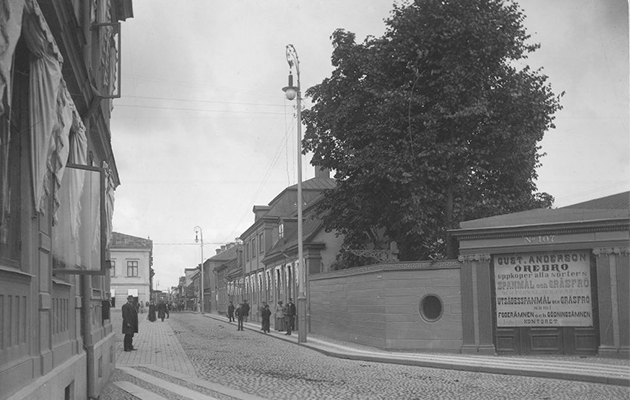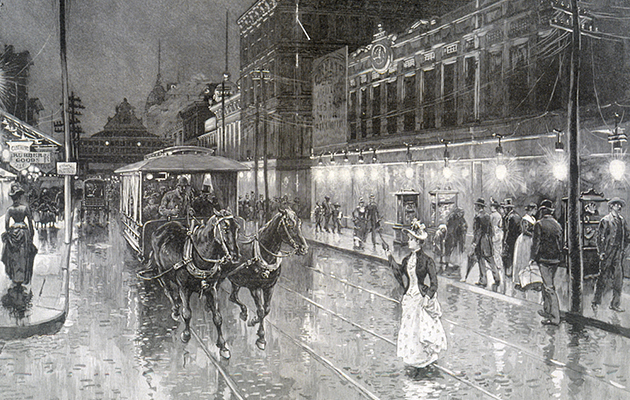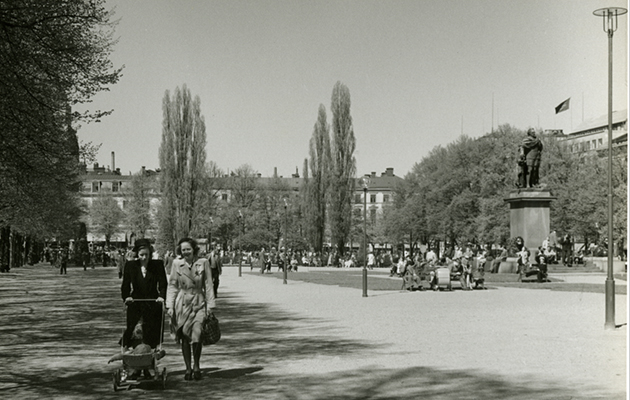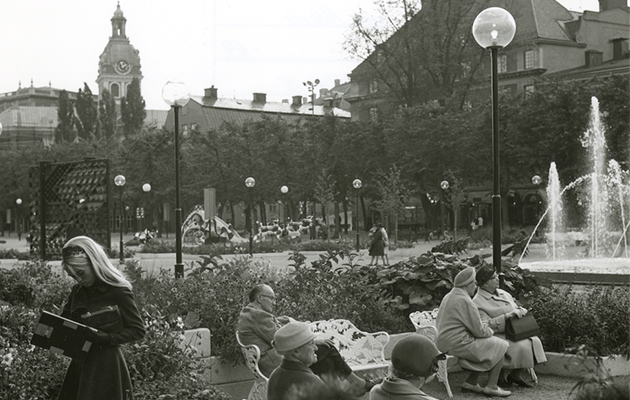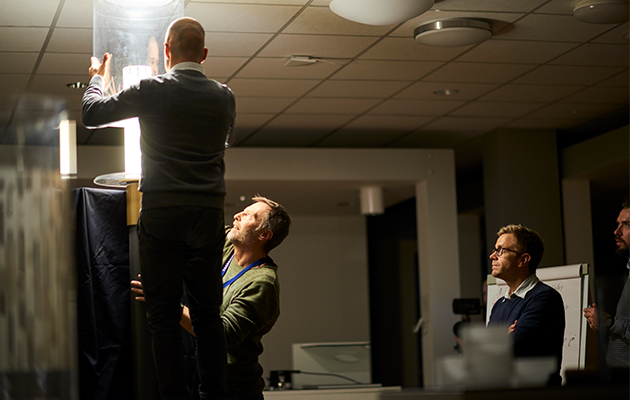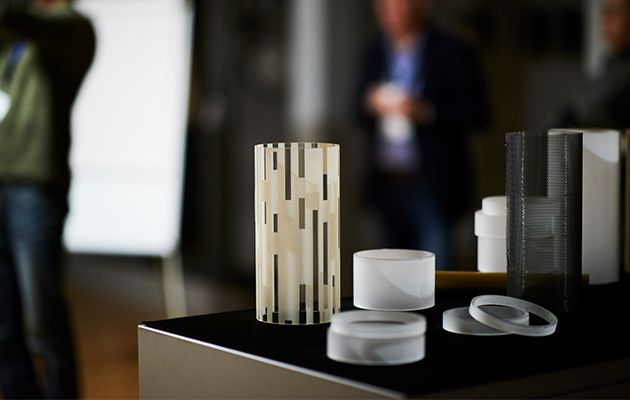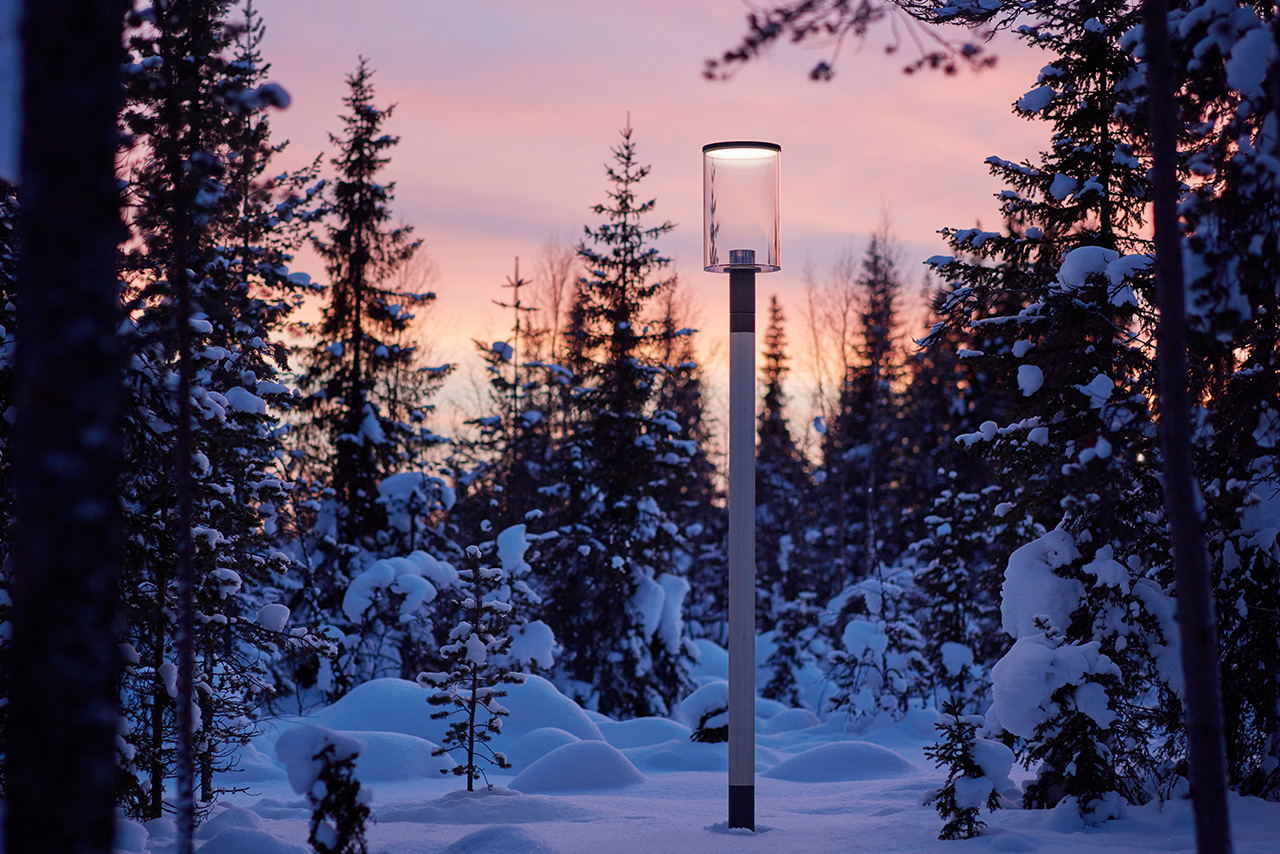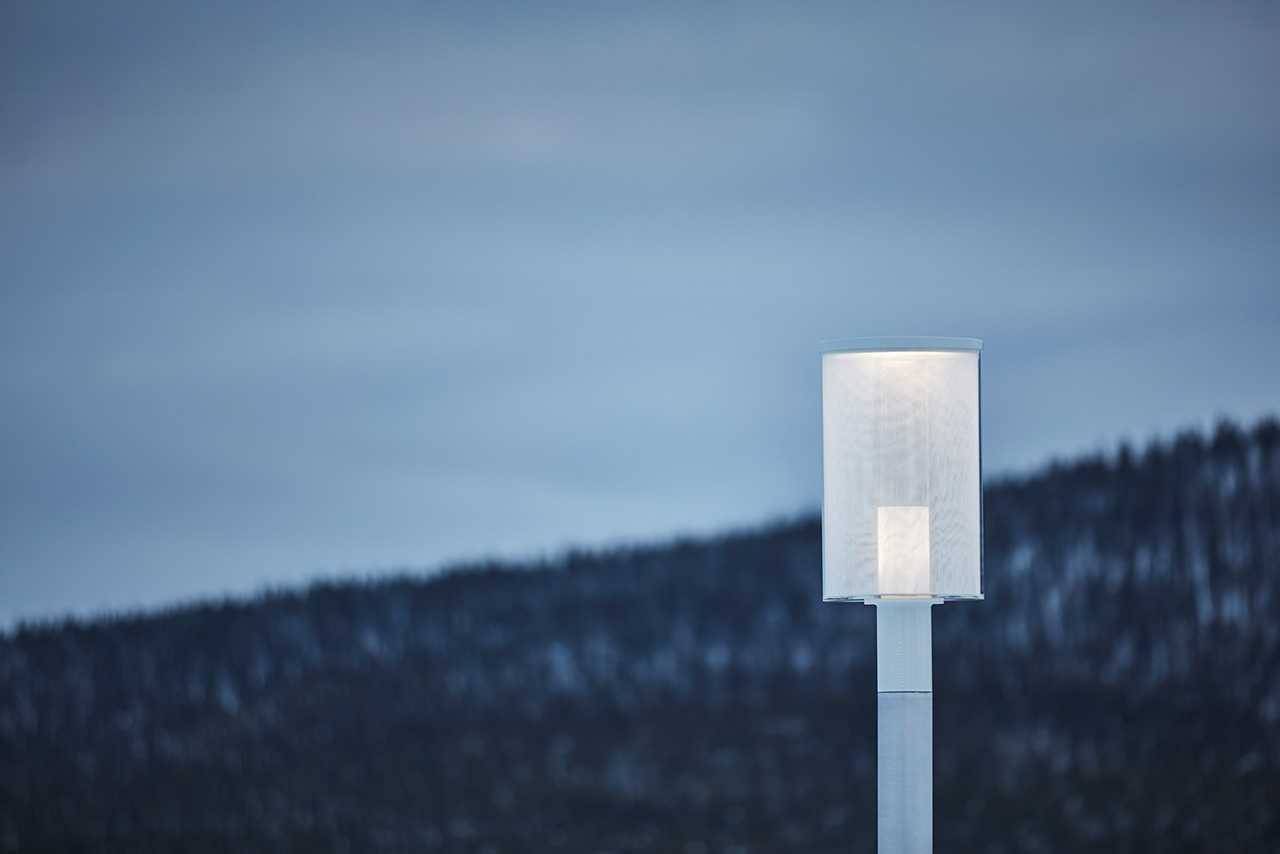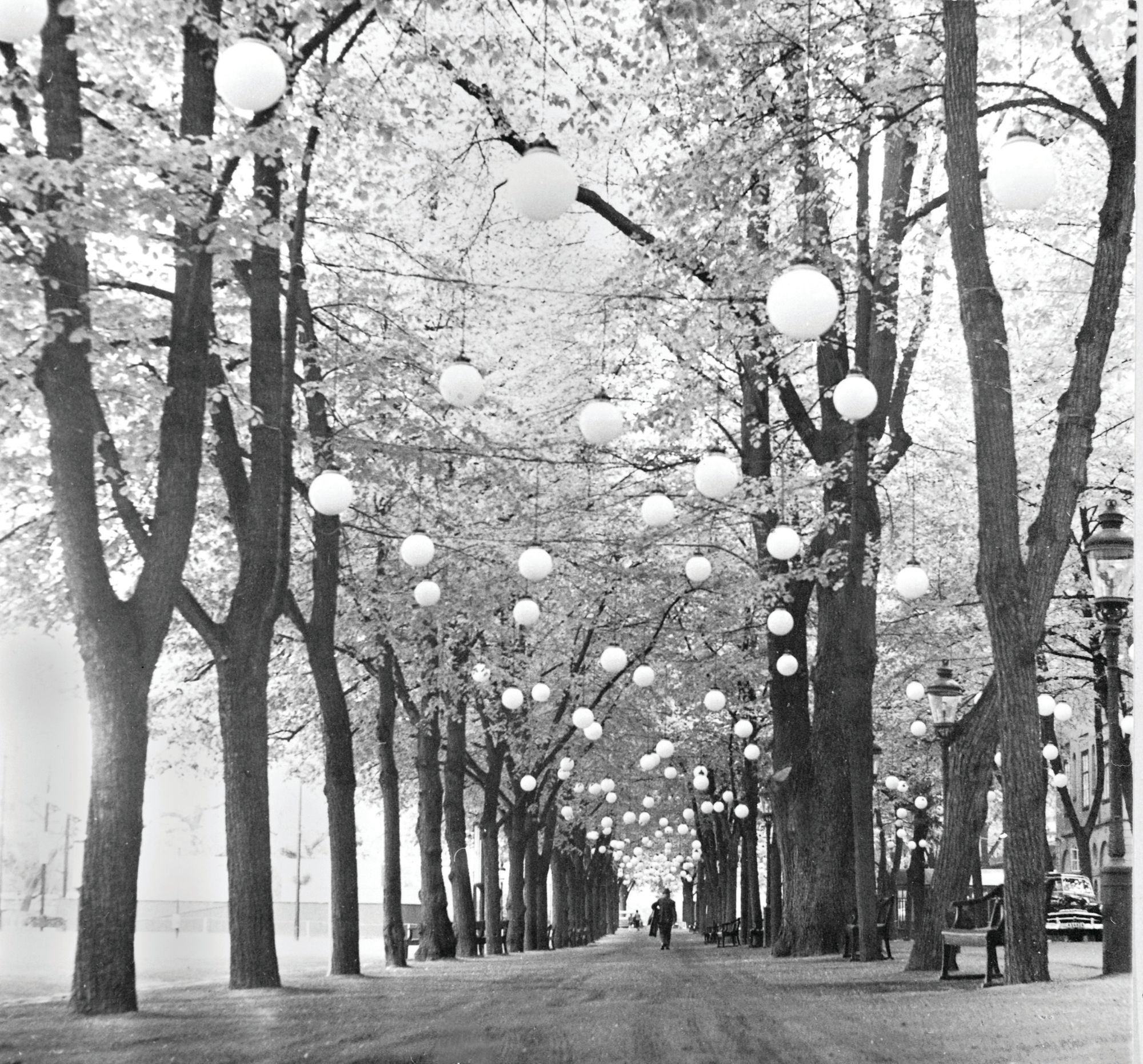
History of the lantern
The design of outdoor lighting has always been determined by the shape of the light source. Not anymore. In co-operation with groundbreaking lighting design firm ÅF Lighting and glass designer Lena Bergström at Orrefors, Fagerhult is reclaiming the natural light with the Devina park luminaire. We are sure Leonardo da Vinci wouldn’t mind.
Once upon a time, there was only the moon lighting up the way for nighttime wanderers. A giant natural floodlight, perfect in its benevolent roundness. If there was no moon or if the night was cloudy, you had two options: staying at home or bringing a hand-held lantern.
In the cities, there were sometimes lighting provided by the city or the property owners – oil lamps on consoles or posts, offering a weak and flickering light. They were never lit after midnight though, not at all if the moon was up.
In the 1850s and 1860s all this changed. Gas light was installed in many of the major Swedish cities, providing new freedom of movement after dark. Still, the designs were adapted to the fact the lantern housed a living flame.
FROM GAS TO ARC LIGHTS
When it comes to lighting design, you have to wait until the 1870’s for something new to happen. That's when electric lighting was first introduced in Sweden, starting with the arc light. The arc light consisted of a glass sphere with two carbon rods and an intense, restless light arc jumping between them.
Gas and electric lighting co-existed into the early 20th century, but as the tungsten filament incandescent lamp was developed it revolutionized lighting design. This light source was superior in so many ways. It provided great light, had a hermetic atmosphere and it could be mounted in any direction without compromising its functionality. From the 1920’s luminaire design attracted leading architects of the society.
A LANTERN NEVER SEEN
To lighting designers, the light source has been both a blessing and a curse – offering new opportunities in brightness and efficiency but also restrictions in shape, explains Tomas Bolin, product manager at Fagerhult Outdoor.
”Traditionally, the design of lanterns has always taken its starting point in the shape of the light source – if designing a new luminaire for the purpose. It has also been quite common to just ‘replace’ the light source, using a new light source in an old shape.”
”Today, LED-technology has come so far that it is finally possible to do it differently. The design is no longer bound to the light source as LED lets designers and architects work freely. That’s why we wanted to do something extrarordinary. We wanted a game changer.”
Tomas and his team turned to Scandinavian lighting authority Kai Piippo and his team at ÅF Lighting. Kai is an award winning lighting designer with an international repute. The mission was to create an innovative lantern for parks and squares. A lantern never seen before. On Fagerhult’s behalf, ÅF Lighting created the guidelines for the groundbreaking design.
THE PERFECT CYLINDER
”I immediately felt that we had to avoid everything that could be outdated or related to a certain decade. It shouldn’t remind of anything that’s been done before. And when seeing it 30 years from now, you shouldn’t think that it’s a 2020’s design”, says Kai Piippo.
We can identify at least three different popular designs that actually has influenced the outdoor lighting design since then; the industry lamp, the lantern with the steel sheet ‘hat’ and the globe”, tells Jan Garnert, lighting historian.
The globe is one of the most beloved shapes dating back to the arc light. Since the 1920’s has been used in countless designs.
”Of course we didn’t want to do the globe again. Especially at is it worthless regarding light ergonomics. With no louvres what so ever, the incandescent lamp in its center feels like a welding flame to the eye, a dazzling barrier between the spectator and the surrounding nature. ”
Still, there is an explanation why we are so incredibly fond of globes and spheres.
”The human eye always searches for symmetry as it exists in nature. So we thought, why not ask nature for advice? One of nature’s most perfect forms is the cylinder. It can be seen everywhere. In the swirls of the snail’s shell and in the vortex of the sparkling creek. It's the same principles described by the golden ratio and in DaVincis’ Vetruvian man. Simplicity and perfection. So, we decided to create a cylinder with the perfect proportions. The simplest and most natural of all forms and extremely difficult to do. But I really think we pulled it off.”
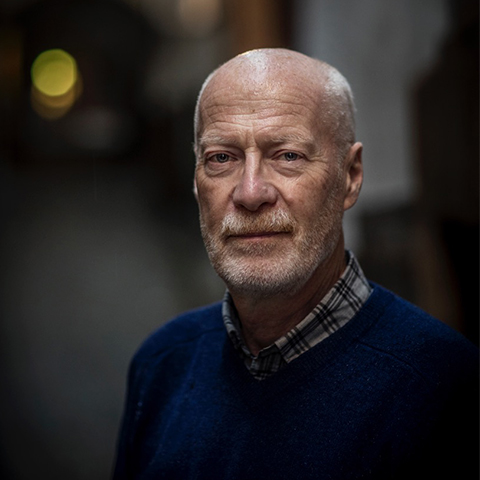 "We can identify at least three different popular designs that actually has influenced the outdoor lighting design since then; the industry lamp, the lantern with the steel sheet ‘hat’ and the globe." Jan Garnert, lighting historian
"We can identify at least three different popular designs that actually has influenced the outdoor lighting design since then; the industry lamp, the lantern with the steel sheet ‘hat’ and the globe." Jan Garnert, lighting historian
AN ANIMATED EXPERIENCE
Another important objective when working with the Devina luminaire, was that it shouldn’t obstruct the surrounding environment. Its using the most advanced LED-technology packed with prestanda and innovative features – but you never see the light source, from any angle. Fagerhult’s strong legacy within lighting comfort shines through in every detail.
”In nature, all living things and creatures are syncronized with their habitat. For example, the fur of the arctic fox is greyish brown in summertime changing into white, blending with the snow during winter. We wanted Devina to have the same features. It should blend into the surrounding nature, creating a sense of light without taking the focus from the beauty around it. Kind of an animated feeling.” says Kai.
STRIVING FOR UNIQUENESS
Aspiring timeless and inspired by eternal beauty the Devina luminaire is expected to change our views on outdoor city lighting.
”We are experiencing a change of paradigm in the customer’s wishes and demands. For the first time, cities want to find their own design instead of going with a standard solution. Lighting and lanterns have become an important part of place branding and cities want luminaires that are unique, expressing the cities character and soul. For example, the ‘Stockholm’ outdoor luminaire range is a Swedish modern classic that was designed by Olle Anderson especially for Stockholm and became a huge success. But if you install Stockholm luminaires in every Swedish city its not that much Stockholm any more, is it?”, Kai asks rethorically.
That’s why the Devina is somewhat related to Plato’s theory of ideas. Based on the cylindric design, customers are free to create their own unique individual using the materials and colours of their choice.
”Devina offers a new way of freedom. She’s the heir to traditional city illumination evolved to support a new lighting paradigm. She allows you to create the mood and experience that you want to express for the particular location”, says Tomas Bolin.
Fagerhult also offers four different pre defined Devina designs inspired by Nordic culture. Each of the four designs are created with the four different seasons in mind; materials and expressions linked to the four elements, different nordic nature phenomenas and times of the day.
”For example, we’ve linked autumn to fire and dawn”, Tomas explains.
In creating the different designs, Fagerhult has put a lot of effort in emphasizing craftsmanship and the Swedish design heritage. A Devina should be experienced as crafted, not manufactured.
”When choosing materials and manufacturing we have cared for the crafted feeling, collaborating with, among others, Swedish glass producer Orrefors and one of Swedens famed glass designers.”
 "The human eye always searches for symmetry as it exists in nature. So we thought, why not ask nature for advice?" Kai Piippo, Head of Design ÅF Lighting
"The human eye always searches for symmetry as it exists in nature. So we thought, why not ask nature for advice?" Kai Piippo, Head of Design ÅF Lighting
TEXT AMELIE BERGMAN
PHOTO CASPER HEDBERG, PATRIK SVEDBERG
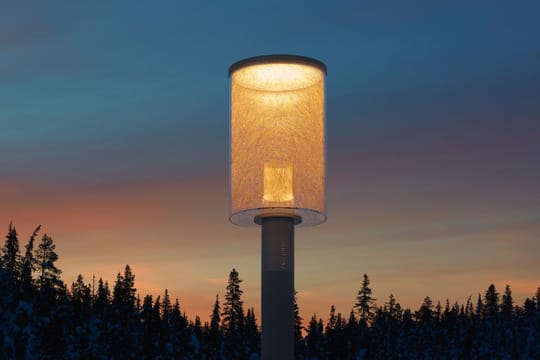
Inspired but not defined by nature
The four pre-defined Devina's are created with the four different seasons in mind; materials and expressions linked to the four elements, different Nordic phenomenas and times of the day.
Read moreRelated News

Melanopic lux: lighting for education influenced by human biology
Light is essential in our daily lives, influencing our ability to see, overall well-being and performance. In educational environments, lighting quality can significantly impact students' focus, mood, and energy levels. So, how do we know what is the right amount and quality of light for this setting? Traditionally, light has been measured in lux, a unit of measurement for the intensity of light. It's used to measure how much light falls on a surface or the amount of light in a given space. One lux is the amount of light that falls on a surface that is one square meter in area when one lumen of light is spread out evenly. Recent advancements in research have unveiled the importance of melanopic lux, which goes beyond mere visibility. This measures how effectively light stimulates specific eye cells that regulate crucial non-visual functions such as sleep and alertness. In classrooms and lecture theatres, the melanopic ratio has become vital in lighting design, enabling educators to create spaces that support visual tasks and align with students' biological rhythms. In this article, we explore how lighting solutions can align with our biology, and how this helps to create optimum conditions for educational environments. The science of vision and light The human eye is a remarkable organ designed for high-resolution colour vision within a small area (approximately 2 degrees of the visual field) while relying on peripheral vision for motion detection. This dual-function system, shaped by evolution for survival, continues to influence how we perceive and interact with our surroundings. Our eyes are particularly susceptible to green and yellow light, reflecting our evolutionary adaptation to naturally lit environments. In contrast, blue light, which is chief in modern LED lighting, requires higher intensity to be perceived at the same level. Effective lighting design carefully considers brightness, timing, and distribution to support visual clarity and biological functions like mood and alertness. For example, exposure to bright light in the morning helps regulate circadian rhythms, boosting alertness and mitigating the effects of seasonal darkness. This is particularly important in educational environments, such as schools and universities, where lighting impacts mood, focus, and overall performance. Our Organic Response system provides an innovative solution tailored for these spaces. This smart lighting technology automatically optimises light levels, featuring daylight-responsive sensors and advanced occupancy detection, maintaining a balance between natural and artificial light. Doing so supports visual comfort and reduces energy consumption, making it an ideal choice for creating dynamic, efficient, and student-friendly learning environments. To further support students, well-lit spaces with minimal glare are essential for reducing eye strain and maintaining focus during extended study sessions. Adjusting light intensity and colour temperature for different tasks—such as reading, group discussions, or creative activities—enhances light's visual and non-visual effects. By integrating thoughtful lighting strategies like those offered by Organic Response, educational environments can promote healthier, more productive, and engaging learning experiences. Integrative lighting: Supporting health and well-being. Integrative lighting (also referred to as human-centred lighting) combines visual and non-visual benefits (such as emotional effects) to support biological rhythms and psychological well-being. This approach goes beyond traditional lighting solutions by considering how light impacts circadian rhythms and hormonal balance. Light exposure in the morning is critical for suppressing melatonin (the sleep hormone) and increasing cortisol (the alertness hormone). Proper timing helps align students' natural rhythms with school schedules, which often require a lot of focus. Consistent exposure to bright, cool light early in the day can enhance energy levels and cognitive performance. The melanopic ratio compares the spectral composition of a light source with daylight. Using this information, you can determine its melanopic lighting intensity. This enables the design of lighting setups that precisely meet both visual and biological lighting needs. Lighting recommendations for educational spaces Each learning environment has unique lighting needs. Libraries benefit from direct lighting on the floor, paired with ambient lighting on walls and ceilings. Vertical shelf lighting (200-300 lx) makes it easier to browse titles. Lecture halls, on the other hand, require glare-free, comfortable lighting with flexible control, ideally with pre-programmed scenarios. In auditoriums and classrooms, strong vertical lighting is crucial for clear visual communication, especially over greater distances, enhancing facial expressions and engagement. General lighting recommendations apply to all educational spaces. Our solutions meet industry standards, ensuring reading and writing areas maintain 500 lx for effective visual tasks. Using daylight-responsive sensors for luminaire rows can reduce energy consumption while maximising natural light. The number and arrangement of luminaires should be adjusted based on the room's size and function to ensure consistent illumination. The role of dynamic lighting A Double Dynamic lighting system can be a game-changer in educational environments. It allows for intensity and colour temperature adjustments to match the specific needs of activities, from quiet reading sessions to collaborative group work. Fagerhult's distinct approach to lighting means that our design is human-centric; we integrate scientific insight into light and human psychology, creating environments that support academic performance and well-being. Our focus on energy efficiency also means our advanced control systems optimise light usage while minimising energy consumption, contributing to a building’s sustainability goals. The customisable setting and flexible solutions ensure that educational environments can create tailored lighting profiles for different times of the day or specific learning activities. Long-term benefits of melanopic lighting Melanopic lighting, designed to mimic the natural light spectrum, helps regulate the circadian rhythm, which is essential for maintaining focus, energy, and emotional balance. In classrooms and study areas, proper lighting can reduce eye strain, improve sleep patterns, and enhance mood, which are critical for students' mental health and academic performance. By incorporating lighting that aligns with our biological needs, schools and universities can foster healthier, more productive learning environments,. This is particularly important during the winter months when daylight is limited. Whether through advanced tuneable white light systems, designs that maximise daylight, or energy-efficient solutions, we are dedicated to leading the way in lighting innovation for educational environments, delivering brighter futures—one classroom at a time.
The inspiration behind Nobel Week Lights: ”Light, art and technology intertwined.”
Nobel Week Lights has quickly become a beloved public celebration. During Nobel Week, Stockholm residents flock outdoors to marvel at the spectacular light installations, where contemporary lighting technology meets artistic expression. ”We aim to create a moment of gathering: around light and around something meaningful”, says Lara Szabo Greisman. Nobel Week Lights is a light festival that illuminates Stockholm during the darkest time of the year – a free cultural experience for everyone. Presented by the Nobel Prize Museum, the festival invites international and local artists, designers and students to create light artworks inspired by the Nobel Prize. The installations shed new light on the scientific discoveries, literature and peace efforts of Nobel laureates while offering a fresh perspective on the city. Fagerhult is Principal Partner of Nobel Week Lights 2024, and this year’s edition features 16 different light installations across Stockholm. The artworks can be experienced from 7–15 December, including ”The Wave”, a light installation by the art collective Vertigo, located in front of the Parliament House where visitors can walk right through the luminous wave. The Wave by Vertigo ”Light and art and creativity is incredibly intertwined because these are technologies that are constantly evolving. So part of the fun working with the artists is that they are constantly testing new technologies. And we see these incredible visual results which are based on just pure innovation”, says Lara Szabo Greisman, co-founder and producer of Nobel Week Lights. Lara Lara Szabo Greisman and Leading Lights by Les Ateliers BK The significance of light as a collective force, its ability to encapsulate life and death, joy and sorrow – indeed, the very essence of what it means to be human – makes lighting a powerful medium of artistic expression, she argues: ”The dream for the festival is that this becomes a personal experience for each and every member of the audience. A moment that they remember and cherish . A moment that they think about later and bring forward as their story of connecting with the city.”
